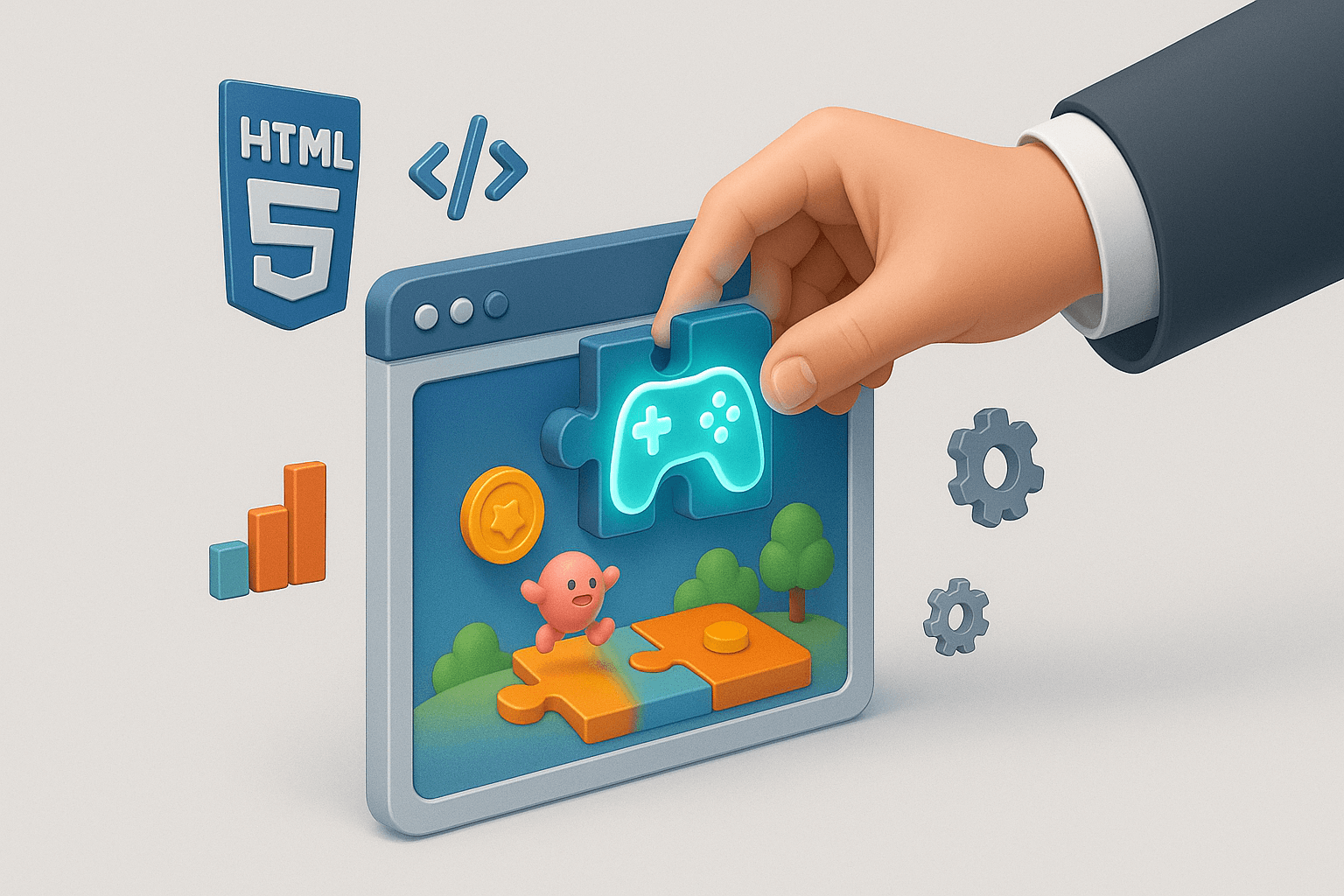Outsourcing HTML5 games has become a key strategy for businesses aiming to captivate their audience in a crowded digital marketplace. In a world where users skip ads and ignore banners, a fast, engaging browser game can make a lasting impression. But what does it take to do it right? The challenge is that game development is a highly specialized skill, and for most companies, building an in-house team isn’t feasible. This is where a strategic approach to outsourcing becomes a game-changer.
This comprehensive guide is written for business leaders, marketing managers, and entrepreneurs. We will walk you through the entire process, from understanding the core benefits of HTML5 to finding the right development partner and navigating the complexities of a project to a successful launch.
Why Choose HTML5 Games? The Key Business Advantages
Before we dive into the “how” of outsourcing, it’s crucial to understand the “why.” What makes HTML5 technology so compelling for businesses compared to traditional native app development? The advantages are clear and directly impact your bottom line.
1. Ultimate Reach: One Game, All Devices (Cross-Platform)
The single greatest advantage of HTML5 is its inherent cross-platform nature. A game built with HTML5 runs on a web browser, meaning it works seamlessly across desktops, laptops, tablets, and smartphones, regardless of the operating system (iOS, Android, Windows). This “write once, run anywhere” approach saves an enormous amount of time and money, as you no longer need to develop and maintain separate versions of your game for different app stores. Your total addressable market becomes anyone with a web browser, which is virtually everyone.
2. Instant Access: No Downloads, No Friction
Think about the typical user journey for a mobile app: the user must go to the app store, search for the app, wait for it to download and install, and then finally open it. Every step in this process is a point where you can lose a potential user. HTML5 games eliminate this friction entirely. A user clicks a link in an ad, a social media post, or on your website, and the game starts instantly in their browser. This immediacy is what makes HTML5 the undisputed king for playable ads and other time-sensitive marketing campaigns, leading to significantly higher conversion rates.
3. Cost-Effective & Faster Time-to-Market
Because you are developing a single version of the game for all platforms, the overall development cost is significantly lower than creating multiple native applications. The development cycle is faster, maintenance is simpler, and updates can be rolled out instantly to all users without needing to go through a lengthy app store approval process. For businesses looking to be agile and responsive, this accelerated time-to-market is a critical competitive advantage.

The Core of the Matter: When to Consider Outsourcing HTML5 Games
When considering outsourcing HTML5 games, the default instinct for many business leaders is to try and build capabilities in-house. While admirable, game development is a unique beast. It’s a blend of highly technical programming and subjective, creative design. The decision to outsource isn’t a sign of weakness; it’s a strategic move based on efficiency, speed, and expertise. Here are the most common scenarios where outsourcing is not just an option, but the best option.
- When You Lack In-House Expertise: This is the most straightforward reason. A successful game requires a team: game designers, 2D/3D artists, animators, developers proficient in specific game engines (like Phaser or Babylon.js), and QA testers. Assembling, hiring, and managing such a team for a single project is a massive undertaking in terms of both time and cost. Outsourcing gives you instant access to a pre-built, experienced team that is ready to go from day one.
- When Speed is Critical: Do you have a product launch in three months and need a promotional game to support it? Is there a holiday season coming up that you want to capitalize on with a marketing campaign? In-house teams are often juggling multiple priorities. An outsourced agency, however, is contractually obligated to focus on your project and meet your deadline. Their entire business model is built around efficient delivery, making them the perfect partner when your time-to-market is non-negotiable.
- When You Need Specialized Skills for a Specific Project: Perhaps your business already has a web development team, but they have no experience in creating multiplayer functionality or integrating complex physics. Instead of retraining your entire team for a one-off project, you can outsource to a studio that has already built dozens of similar games. This allows you to tap into specialized knowledge for your outsourcing of HTML5 games exactly when you need it, without the long-term overhead.
Your Step-by-Step Guide to Outsourcing HTML5 Games
Once you’ve made the decision to outsource, the next challenge is finding and hiring the right partner. This process can seem daunting, but by breaking it down into logical steps, you can confidently navigate the landscape of outsourcing HTML5 games and find a team that will turn your vision into a reality.
Step 1: Defining Your Project Scope & Budget
Before you can find the right partner, you must first understand what you want to build. You cannot get an accurate quote or find a relevant developer without a clear plan. Create a simple project brief that outlines the following:
- Game Concept: What is the core idea of the game? Is it a puzzle, a platformer, an educational quiz? How does the player win? Be as detailed as possible.
- Target Audience: Who are you trying to reach? This will influence the art style, difficulty, and overall tone of the game.
- Key Features: List the “must-have” features. This could include a leaderboard, social sharing buttons, user registration, or multiple levels. Separate these from “nice-to-have” features to manage scope.
- Reference Materials: Are there other games that you like the look and feel of? Providing examples is one of the best ways to communicate your vision.
- Budget: Be realistic about your budget. While the cost can vary wildly, having a range in mind helps filter out partners who are not a good fit. A simple game can cost a few thousand dollars, while a more complex project can run into the tens of thousands.
Step 2: Where to Find Development Partners
There are two primary avenues for finding talent: freelancer platforms and specialized development agencies.
- Freelance Platforms (e.g., Upwork, Toptal): These platforms give you access to a global pool of individual developers. This can be a cost-effective option for smaller, well-defined projects. However, you will be responsible for managing the freelancer, coordinating with artists or other roles yourself, and assuming more of the project management burden.
- Specialized Agencies: A game development agency provides an all-in-one solution. They have a full team of designers, artists, developers, and project managers. While typically more expensive than a single freelancer, they offer a more streamlined, hands-off experience and are better equipped to handle complex, long-term projects. They take full responsibility for delivering the final product.
Step 3: Vetting Potential Partners (The Crucial Checklist)
This is the most critical step in the process of outsourcing HTML5 games. Never hire the first partner you speak to. Take the time to properly vet at least 3-4 potential candidates. Here is a checklist to guide you:
- Review Their Portfolio: This is non-negotiable. Look for evidence that they have built games similar to your concept. Do they have experience with browser games? Do their games look polished and professional? Do they showcase a variety of styles?
- Check Reviews and Case Studies: Look for testimonials from past clients. A reputable agency will have detailed case studies on their website that outline the client’s problem, the solution they provided, and the results.
- Conduct an Interview: A video call is essential to gauge their professionalism and communication skills. Are they asking smart questions about your project? Do they seem genuinely interested in your business goals?
- Discuss Intellectual Property (IP) and Security: This is a deal-breaker. You must have a frank conversation about who owns the final code and game assets. A professional partner will have no problem signing a Non-Disclosure Agreement (NDA) to protect your idea before you even share the full details. They should also be able to clearly state in the contract that the final Intellectual Property belongs to you, the client.
Step 4: Understanding the Engagement Model
How will you pay your development partner? There are typically two models:
- Fixed Price: This model is best for smaller projects with a very clearly defined scope. You agree on a single price for the entire project. It’s predictable, but any changes or additions to the scope will cost extra.
- Time & Materials: This model is more flexible and better for larger, more complex projects where the scope might evolve. You pay an hourly or daily rate for the time the team spends on your project. It offers more flexibility but requires more monitoring of the budget.
Step 5: Effective Project Management and Communication
Once you’ve signed a contract, the work begins. Insist on a clear communication plan. A professional agency will use project management tools like Jira, Asana, or Trello to provide you with visibility into the project’s progress. You should expect regular updates (e.g., weekly check-ins or milestone reviews) to see demos of the game, provide feedback, and ensure the project is staying on track.
Common Pitfalls to Avoid When Outsourcing HTML5 Games
When you’re outsourcing HTML5 games, knowing what to do is important, but knowing what not to do can save you from costly mistakes. Here are three common traps to avoid:
- The Vague Requirements Trap: Starting a project with a fuzzy idea like “let’s make a fun game” is a recipe for disaster. This leads to endless revisions, misunderstandings, and “scope creep,” where the project grows uncontrollably, busting both your timeline and your budget. Invest time in creating a clear brief (as described in Step 1) before you even start looking for partners.
- The “Black Box” Problem: You should never feel like you’ve handed over your money and have no idea what’s happening. Avoid partners who are poor communicators or who are not transparent about their process. If you have to constantly chase them for updates, it’s a major red flag. Good partners are proactive in their communication.
- The IP & Contract Nightmare: A handshake and an email are not a contract. A professional relationship must be protected by a clear legal agreement that outlines the scope of work, payment schedule, timeline, and, most importantly, explicitly states that you are the sole owner of all intellectual property created. Skipping this step can lead to devastating legal battles down the road.
Conclusion: Your Game, Your Growth
In a world saturated with traditional advertising, HTML5 games offer a fresh, powerful, and effective way to engage with your audience. They break down barriers, create memorable brand experiences, and provide measurable results. For most businesses, the smartest and most efficient way to tap into this power is through the strategic outsourcing of HTML5 games.
By following a structured process—defining your vision, meticulously vetting your partners, and insisting on clear communication and legal protections—you can mitigate the risks and unlock the immense potential of this technology. Outsourcing HTML5 games is more than just hiring a coder; it’s about forming a partnership with a creative and technical team that can help you build not just a game, but a valuable asset for your business’s future. The first step is to take your idea seriously, and the next is to find the right experts to bring it to life.
